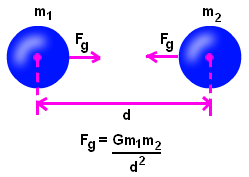
Force of attraction is a force that draws an object close due to its attraction. There are many attractive forces existing in nature. Some of them are gravitational force, electrostatic force, electric force, magnetic force. Gravitational force is very well known example for force of attraction as it attracts objects towards itself irrespective of its distance. The Newton's universal law of gravitation explains a lot more about how this force acts. It states that every mass that exist in the universe attracts some or other mass in the universe. It justifies the fact that anybody thrown up comes down.
Lets take two masses m1 and m2 separated by a distance d.

The force of attraction formula is given by,
F$_g$ = - $\frac{Gm_1m_2}{d^2}$.
Where,G is the gravitational constant (6.67 $\times$ 10-11 Nm2/kg2),
m1 is the mass of object 1,
m2 is the mass of object 2,
d is the distance between two objects.
This formula helps out in finding the force acting between any two bodies having a larger mass because in smaller masses this force is negligible.
Below are given some examples on force of attraction:Question 1: Calculate the gravitational force acts between two bodies of masses 20, 000 kg and 50, 000 kg separated by a distance of 50 m.
Solution:
Given: mass m1 = 20000 kg, mass m2 = 50000 kg, radius r = 50 m, Gravitational constant G = 6.67 $\times$ 10-11 Nm2/kg2
The force due to gravity is given by,
F = $\frac{GM_1M_2}{r^2}$F = $\frac{6.67 \times 10^-{11} Nm^2/kg^2 \times 20000 \times 50000}{50^2}$
F = 2.67 $\times$ 10-5 N.
Therefore, the gravitational force is 2.67 $\times$ 10$^{-5}$ N between the two bodies.
Question 2: A body of weight 80 kg is 2 m far away from body of weight 50 kg. Calculate the gravitational force acting between them.
Solution:
Given: mass m1 = 80 kg, mass m2 = 50 kg, radius r = 2 m, Gravitational constant G = 6.67 $\times$ 10-11 Nm2/kg2








